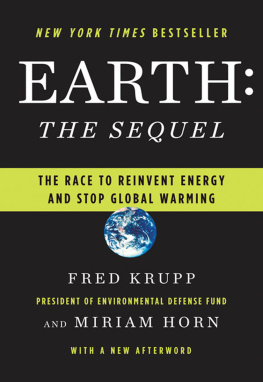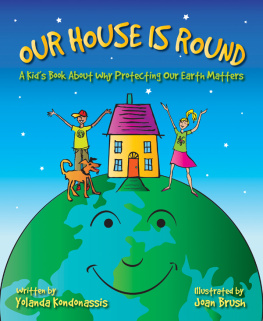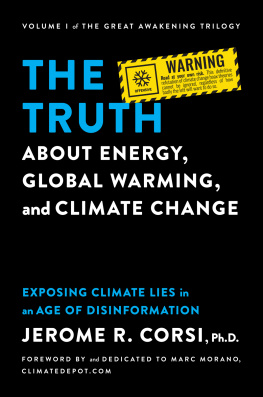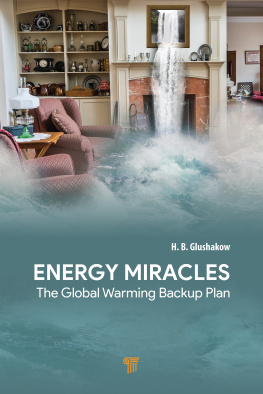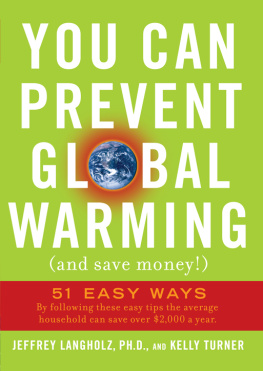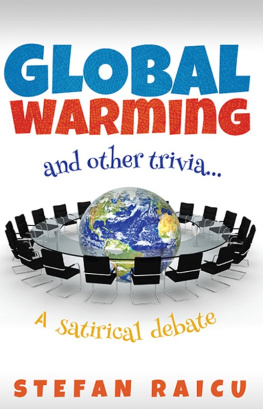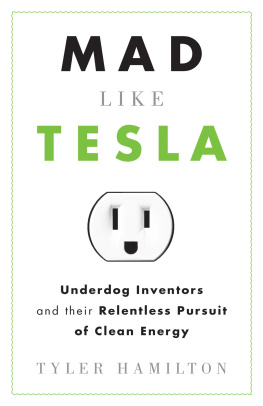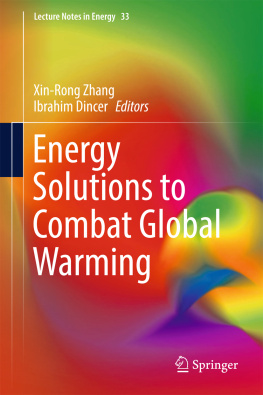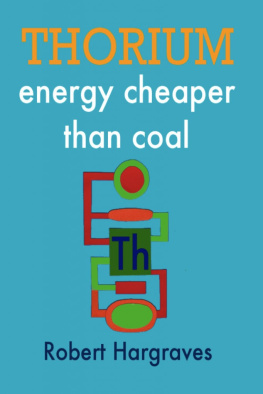W. W. N ORTON & C OMPANY
For information about permission to reproduce selections from this book, write to Permissions, W. W. Norton & Company, Inc.,
500 Fifth Avenue, New York, NY 10110
Krupp, Fred.
Earth, the sequel: the race to reinvent energy and stop global warming/Fred Krupp and Miriam Horn.
p. cm.
1. Energy conservationUnited States. 2. Global warming. I. Horn,
Miriam. II. Title.
TJ163.4.U6K78 2008
621.042dc22
W. W. Norton & Company, Inc.
500 Fifth Avenue, New York, N.Y. 10110
W. W. Norton & Company Ltd.
Castle House, 75/76 Wells Street, London W1T 3QT
C HAPTER 1
A New Industrial Revolution
A revolution is on the horizon: a wholesale transformation of the world economy and the way people live. This revolution will depend on industrial technologycapital-intensive, shovel-in-the-ground industriesand will almost certainly create the great fortunes of the twenty-first century. But this new industrial revolution holds a more important promise: securing the world against the dangers of global warming. It is developing amid the political, economic, and technological equivalent of the perfect storm: worldwide concern about the enormous threat of greenhouse gases, growing realization that we are prisoners of petroleumhostage to the unstable, sometimes hostile, regimes that control the supplies of crude oil and natural gasand, finally, huge and accelerating advances in technology that make possible unprecedented breakthroughs in how we make and use energy.
This book is about the kinds of inventors who will stabilize our climate, generate enormous economic growth, and save the planet. It is also about the near certainty that unless the United States acts as a nation to give these innovators the chance to compete fairly in the worlds biggest business, they will fail to avert the crisis in time.
A BIT OF CLEAN-AIR HISTORY will explain how U.S. leadership can solve the most dire environmental problem of our timeshow collectively we can head off catastrophe, create wealth and jobs, and enhance our security.
Thirty years ago, scientists and fishermen began noticing a startling decline in animal and plant life in lakes and forests throughout the eastern United States. In 1981 the National Academy of Sciences issued a report documenting the cause: sulfur dioxide (SO2) pollution. Originating mostly from coal-fired power plants, sulfur dioxide was causing rain and snow to turn acidic, and that acid rain was killing aquatic life and damaging forests.
The discovery sparked bitter debate over how to reduce sulfur dioxide emissions and at what cost. The key instrument then available for tackling acid rain was the 1977 Clean Air Act, which had established a command and control approach to air pollution. Not only was every newly built electric generating unit required to meet a uniform ceiling on its emissions rate, but it had to do so by installing a scrubber, or flue-gas desulfurization unit, an expensive piece of capital equipment that added tens of millions of dollars to the cost of the power plant. It didnt matter if a power plant could cut emissions more cheaply by burning cleaner coal or by making its boiler more efficientit still had to install a scrubber. Meanwhile, overall emissions continued to rise: old plants were largely exempted until they modernized, and new plants, even if in compliance with the law, still added new emissions to the total.
The one-size-fits-all solution failed to take advantage of the local knowledge and experience of plant operators. It actually impeded quick adoption of new technologies. And it made the whole process far more expensive than necessary: some existing plants could cut pollution cheaply but werent asked to, while other plants spent a fortune to comply.
By the 1980s, Environmental Defense Fund had taken the lead in arguing for a different approach. The key was to mobilize the market: to make far deeper cuts in pollution and at much lower cost. During the 1988 presidential election, strong pressure by New Hampshire environmentalists elevated acid rain as an issue all candidates had to address. Soon after George H. W. Bush was elected president, Environmental Defense Fund president Fred Krupp met with White House counsel C. Boyden Gray. He outlined for Gray how the presidents campaign pledge to curb acid rain could be fulfilled using the worlds first emissions cap and trading system. He argued that the president could be more ambitious on the environmental goals while still garnering business support. After dozens of meetings, the Bush administration embraced Environmental Defense Funds proposal and submitted it to Congress, whichled by Senator George Mitchell of Maine and Representatives Henry Waxman of California and John Dingell of Michiganwrote it into the Clean Air Act of 1990.
The law started with the scientific bottom line. It required a 50 percent cut in sulfur dioxide emissions from the total volume released by fossil fuelfired power plantsthe minimum reduction that atmospheric scientists believed was necessary to begin bringing lakes and rivers back to life. It set a permanent upper limita capon these emissions, then divvied up the quantity (in tons) of pollution allowed among the power plants. Even as new sources of pollution came on line, the cap was ratcheted down over time so that the total amount of pollution fell. That declining cap, guaranteeing that environmental targets would be met, was unprecedented. But it was the second part of the lawthe emissions-trading systemthat completely transformed the paradigm that had historically pitted environmentalism against economic growth.
The trading mechanism allowed a power plant that cut its sulfur dioxide pollution more than required to sell those extra allowances, and permitted plants that could not find a better way to cut their own emissions to buy them. A new commodities market was born. A plant that could beat its emissions target had a profitable new asset to sell, and financial incentive to develop ways to cut emissions even further. The buyer had the flexibility to find the cheapest way to meet the cap; it was now the power plant operatornot the regulatorwho decided how to integrate emissions control into an overall business plan.
Two months after the law was passed, Richard Clark, then CEO of Pacific Gas and Electric, Americas largest publicly owned utility, sat next to Fred Krupp at a dinner for the Presidents Commission on Environmental Quality. When you were talking to the president about this cap-and-trade idea, I frankly thought youd lost it, he said to Fred. But now that theres a way to make money from cutting pollution, I have a dozen proposals for emissions reductions from my own employees on the shop floor, and a dozen more from outside consultants. The environment isnt just a money loserits a profit center. I have to admit its a powerful law.
One company that jumped on the new market opportunity was General Electric (GE), whose scrubber technologyin the absence of strict caps on emissions or any rewards for overachievershad not advanced much since passage of the 1977 law. For years, GE had been selling clumsy units that clogged up so frequently that operators had to build two parallel scrubbers to make sure one was always running. Eli Gal, whose current carbon-cutting work is featured in Chapter 8, was then at GE Environmental Services, and he recalls how quickly that all changed once the cap-and-trade mechanism became law. GE began devoting serious resources to clean-up technology, and Gals team had its breakthrough: it devised a scrubber that turned the sulfur dioxide into gypsum, which does not gum up the works and is itself a marketable product.

